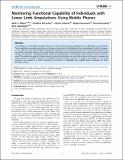Monitoring Functional Capability of Individuals with Lower Limb Amputations Using Mobile Phones
Author(s)
Albert, Mark V.; Valentin, Juliana; Herrmann, Megan; Kording, Konrad P.; Jayaraman, Arun; McCarthy, Cliodhna M.; ... Show more Show less
DownloadAlbert-2013-Monitoring Functiona.pdf (483.3Kb)
PUBLISHER_CC
Publisher with Creative Commons License
Creative Commons Attribution
Terms of use
Metadata
Show full item recordAbstract
To be effective, a prescribed prosthetic device must match the functional requirements and capabilities of each patient. These capabilities are usually assessed by a clinician and reported by the Medicare K-level designation of mobility. However, it is not clear how the K-level designation objectively relates to the use of prostheses outside of a clinical environment. Here, we quantify participant activity using mobile phones and relate activity measured during real world activity to the assigned K-levels. We observe a correlation between K-level and the proportion of moderate to high activity over the course of a week. This relationship suggests that accelerometry-based technologies such as mobile phones can be used to evaluate real world activity for mobility assessment. Quantifying everyday activity promises to improve assessment of real world prosthesis use, leading to a better matching of prostheses to individuals and enabling better evaluations of future prosthetic devices.
Date issued
2013-06Department
Massachusetts Institute of Technology. Department of Mechanical EngineeringJournal
PLoS ONE
Publisher
Public Library of Science
Citation
Albert, Mark V., Cliodhna McCarthy, Juliana Valentin, Megan Herrmann, Konrad Kording, and Arun Jayaraman. “Monitoring Functional Capability of Individuals with Lower Limb Amputations Using Mobile Phones.” Edited by Miklos S. Kellermayer. PLoS ONE 8, no. 6 (June 4, 2013): e65340.
Version: Final published version
ISSN
1932-6203